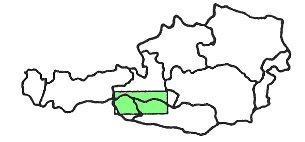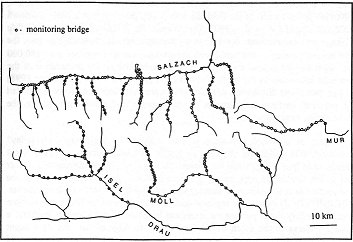 |
Last Update:
Thursday November 22, 2018
|
| [Home] |
The area of the Hohe Tauern mountains is a region in the Austrian Alps, which is still left largely in its natural state. It encompasses the Hohe Tauern National Park and includes parts of the federal states of Tyrol, Salzburg and Carinthia ( Fig. 1 ). But even in this remote area, some of the larger vertebrates were extirpated by man, among them the otter. Today the question is being considered of whether to enable these former inhabitants to return, and furthermore, how this could be done. As re-introductions of bearded vulture (Gypaetus barbatus) and ibex (Capra ibex) have been very successful, discussions about the otter as a potential candidate have arisen.
Therefore a study was carried out to answer questions about the past, present and future of the otter and its habitat in the Hohe Tauern region. To determine the current distribution of otters within the study area, 242 bridges ( Fig. 2 ) and their surrounding banks were searched for indirect signs on three occasions (April/May, August, November 1994).
By checking old hunting records, historical data and sending out more than 2000 questionnaires and questioning local and skilled people, a detailed inquiry on the historical and present state of the otter was conducted. A second topic of this survey was the assessment of habitat in the region. For this purpose, the historical development of rivers up until today was researched, and an evaluation of the current situation was carried out in order to estimate the suitability of the region as an otter habitat and develop suggestions for improvement. As old hunting records confirm, a surprisingly large number of otters must have lived in this alpine region. Up to the end of the previous century, dozens of otters had been killed every year, an undertaking which was boosted by offering rewards. This partly intensive hunting probably weakened the population, and until the thirties, the occurrences of otters diminished. The disappearance of the otter intensified in the fifties and sixties, although the otter was fully protected against persecution. The main reasons for the disappearance were most likely the far-reaching changes to rivers as a result of engineering, large-scale drainages of wetland and lastly and most damagingly, the extensive hydroelectrical exploitation of rivers and streams. Typically for alpine regions, all human influence had been concentrated upon the valleys around the rivers, whereas the unspoilt mountain streams were too poor in fish to support an otter. In addition, in the Tyrolean and Carinthian parts of the region, heavy flood disasters in the sixties were perhaps responsible for the extinction of the last remaining otters. Since the seventies, otters have hardly ever been seen in the Hohe Tauern region. At present, no permanent otter population can be found in the study area, but obviously single animals stay in the region occasionally. The fact that the natural recovery of a population has not yet happened can be explained on the one hand by a weak immigration from the surroundings which hold no or few otters, and on the other hand by the limited suitability of the area as an otter habitat. Generally speaking, the Hohe Tauern region in its present state is only partly suitable for otters. Most areas which seem superficially appropriate with respect to river morphology, bank side and hinterland have in fact been largely devaluated as a consequence of hydroelectrical usage: storage power stations leave large stretches of riverbed without water for months, while surges and huge fluctuations of water levels occur every now and then. For these reasons, the plan to re-introduce European otters was rejected, since the success of such an operation would seem remote on the grounds of the state of the habitat. As a natural recolonialization from the south and east might be taking place, it is simpler and more useful to support this as far as possible. Top priority must definitely be the improvement of the habitat. Rivers should be granted more space and natural dynamics at least in some parts, river banks should be left more to themselves, and especially the effects of hydroelectrical exploitation must be reduced. Then existing and immigrating otters would find better conditions, and chances for a natural re-colonization would arise. The complete survey is published in German in:
Jahrl, J. (1995).
Historische und aktuelle Situation
des Fischotters (Lutra lutra) und seines Lebensraumes
in der Nationalparkregion Hohe Tauern -
Situationsanalyse und Maßnahmenvorschläge.
Mitteilungen des Hauses der Natur, 12: 29-77
|
| [Copyright © 2006 - 2050 IUCN/SSC OSG] | [Home] | [Contact Us] |

